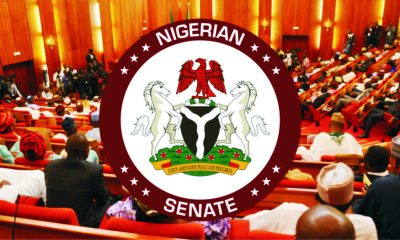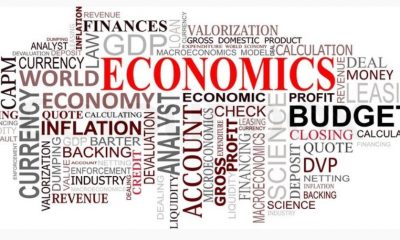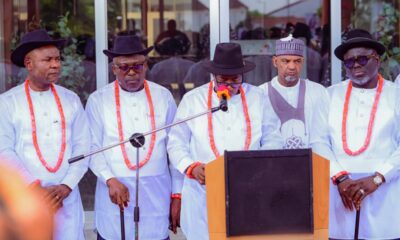Oil & Energy
Role Of Long-Term International Partner In Nigeria’s Future
Ian Craig, graduate of Heriot-Watt University, and Harvard Business School in the United States and a chartered engineer in both civil and mechanical disciplines is the Regional Executive Vice President for Sub Sahara Africa, Shell Upstream International. He presented this paper last month at the Nigeria Oil and Gas Conference and Exhibition in Abuja. Excerpts.
It is a great pleasure to be invited to address, “The Role Of The Long-Term International Partner In Nigeria’s Future”. Let me start with the obvious. Shell has been a partner in Nigeria for decades. Our aim is to be the preferred partner for many decades to come. But to do that, we need to demonstrate that we understand the changing needs of the country and can respond appropriately.
Partnership between international oil companies – which I will refer to as IOCs and National Oil Companies or NOCs – is a long-established and, in most cases, highly successful way to exploit natural resources and develop capability. Shell has many such relationships, several of which have stood the test of half a century or more of collaborative growth.
The key, of course, is mutual benefit. The host government has to be convinced that the IOC is meeting the country’s need, in a responsible manner and at a cost, they can accept. The IOC has to demonstrate that it brings real value to the partnership.
Equally, the IOC has to make a return on its investment, which reflects the risks, be comfortable with the business framework and be confident in the long-term future. A fair balance of risk and reward is essential to a long-term value-driven partnership.
It is not uncommon for major projects to take a decade or more from exploration to first production. Many billions of dollars may be committed against returns, which may take years of production to recover costs. If fiscal terms, political stability and sanctity of contract cannot be relied on, IOCs will hesitate to invest, choosing instead to put their money into provinces where the climate is more dependable.
We must also acknowledge that the expectations of governments and the societies they represent evolve over time. It is clear that, what was appropriate for a country 50 or 60 years or more ago, when its oil industry, and perhaps, the country itself, was in its infancy, will not be appropriate today. The technical and commercial aspects of the business also change as, for example, the challenges grow as oil and gas become more difficult to find and produce.
It follows that with both the socio-political climate and the oil and gas industry continually changing, the IOC/NOC relationship must also evolve. What used to be a simple need for technology or access to capital is now a much more complex relationship. Despite these changes, NOC/IOC partnerships still have a pivotal role to play in the development of the industry.
A good example of a recent partnership is Qatar, where Shell and Qatar Petroleum are collaborating to build the world’s largest gas-to-liquids (GTL) plant. Shell is one of the world leaders in GTL technology. We have, for example, been running a plant in Malaysia· for over 15 years. Qatar is rich in gas with the third largest reserves in the world. Shell’s technology, therefore, provided an opportunity for Qatar to increase its diversification from gas into petroleum liquids and to establish itself as one of the world leaders in the supply of cleaner liquid fuels to new markets.
The Pearl GTL project will come on stream later this year but Qatargas 4, another project borne out of the partnership with Qatar, exported its first LNG cargo to the fast growing Indian market about mid-February. Of course, as in any partnership, the NOC/IOC relationship would not always be perfectly harmonious. But, what we have learned from the long-term relationships we have enjoyed is that if both parties have a will to do so, there is always a way to resolve differences to the satisfaction of all.
Let me give you an example. Before I moved to Africa, I was based in Russia, leading the Sakhalin II development, which was, at the time, the single largest integrated oil and gas project in the world. Many of you are aware that Gazprom was a late entrant to that project, and their entry, reflecting an understandable desire by the Russian Federation to have more involvement, was somewhat controversial.
However, following agreeing the terms of Gazprom’s entry, the project has gone from strength to strength with both Gazprom and the IOC partners benefiting from the expertise of the other investors. Indeed, in November last year, Gazprom and Shell signed a protocol on strategic global cooperation, which had no doubt, been partly enabled by the years of trust built through working together on Sakhalin.
Turning to Africa, it is not long since the development of the continent’s oil and gas resources relied almost entirely on IOCs. Today, there are new players, relationships and dynamics. Here in Nigeria, for example, there are a number of capable, independent indigenous companies breaking into the business. They are hungry for growth and willing to invest in developing fields that may, in the long run, not be core assets for an IOC.
This reflects what has already happened in other maturing provinces such as the Gulf of Mexico or the North Sea, where IOCs have divested older or marginal fields – fields in which they saw greater opportunity for other companies – and consolidated their operations in areas where they could add the most value.
Shell and its partners in Shell Petroleum Development Company of Nigeria (SPDC) have already divested some onshore blocks to indigenous companies. We see this as a natural progression, which allows us to focus our resources on the areas where we can really make a difference. The changes of ownership also assist in broadening the industry and accelerating the development of local capabilities.
Diversity among NOCs is also growing. Some, often driven by limited domestic resources, have expanded their operations overseas. I think of the likes of Malaysia’s Petronas, Brazil’s Petrobras, India’s ONGC, and of course, Gazprom and PetroChina, there are many others. They have evolved into what we might describe as International NOCs or INOCs; still largely state-controlled but now vying with the well established players to enter into partnership with major resource holders around the world.
So, there is now much more of a symbiotic relationship developing. The IOC may partner with the INOC in its host country, but may also partner with it in a third country. For example, Shell and PetroChina partnered outside China for the first time when they jointly acquired Arrow Energy in Australia to develop Coal Bed Methane and LNG projects.
Today, then the major resource holder has a number of options regarding who to partner with ranging from the traditional IOC, a foreign or International NOC, a foreign or indigenous independent, or a combination of any of the above. Each has a potential role to play. The optimal choice depends on the needs of the country, the skills and competence of the host country NOC, the maturity of the industry and the critical success factors for the exploration or development opportunity, which is under consideration.
For example, a small, relatively simple, onshore field may be ideally suited for an independent indigenous company. On the other hand, a highly complex deepwater project, a major gas development or a complex enhanced oil recovery scheme would most likely need the expertise of an IOC. IOC’s strengths lie in developing new frontiers and technologies, management of major projects, accessing capital at competitive rates, market leverage across the whole value chain, and of course, developing local capability.
Let me give you an example of developing local capability: in the course of the Bonga deepwater development, we helped create the first generation of Nigerians with deepwater experience. We could not do this in Nigeria so we temporarily assigned many key staff to our deepwater centre in Houston. Today, over 85 per cent of Bonga’s core offshore staff is Nigerian, and we have the first generation of Nigerian deepwater specialists to support and grow the sector.
We also help to build local skills and businesses. Three of the Bonga modules were designed and built in Nigeria and half of the process vessels on the 1billion cubic metres per day Gbaran Ubie project, which carne on stream last year, were fabricated in the country. This benefit extends to the many thousands of small businesses that supply the industry and the hundreds of thousands of individuals who develop skills through working on our projects.
Let me now turn to the future role of IOCs in Nigeria.
As I mentioned in my opening remarks, our history here is long – Shell has been associated with many milestones in the development of Nigeria’s oil and gas industry from the first oil discovery, the development of domestic and export gas, the opening up of the deepwater play, and even power generation with the newly commissioned 650 MW Afam VI power station.
All of these landmarks could not be possible, of course, without the collaboration of all our partners, including the Nigerian National Petroleum Corporation (NNPC). What these milestones have in common is that they represent, in one way or another, step changes in the industry, and if you look at the history of the oil and gas industry globally, it is typically the IOCs that have taken the major risks and pushed into the frontiers.
I think the role of the IOC in Nigeria is as an industry leader or an enabler. In the future, as in the past, we should have a key role to play in the next phase of the country’s development. Nigeria has enjoyed a leading position in Sub-Saharan Africa through onshore oil, LNG and deepwater development. As time goes on, and the industry matures, a number of challenges must be addressed.
More needs to be done to harness the substantial gas resources, which means much more domestic gas for power generation and for industry, more LNG and possible step-outs such as GTL or export via pipeline as we see being pioneered by the West Africa Gas Pipeline. But large scale gas and power developments are more challenging and much more capital intensive than exploiting onshore oil fields. They also require very close partnership with the government all the way through the value chain.
And so, what is the role of the IOC in this next phase? The answer is not going to be, primarily, as a bringer of capital – though that will, of course, be a major consideration, rather, it will be as a bringer of global expertise and leading edge technology, and that, I believe, is the differentiator.
The thing that sets IOCs apart from the independents and the technical contractors, for the most part, is the scale of their research and development efforts and the depth of their experience. And, of course, our global reach that enables, for example, remote real time monitoring of drilling or production operations by experts anywhere in the world – so a drilling engineer in Houston can support an operation in the Far East and vice versa.
Similarly, the lessons learned, or new techniques applied to, say, deepwater wells in the Gulf of Mexico can immediately be applied to a deepwater well offshore Malaysia or Nigeria or Brazil.
Nigeria’s other under-developed arena is the deepwater. The Nigeria deepwater province produces around 600,000 barrels per day, and has helped to sustain revenues despite the fall in onshore production. Bonga, and other similar developments, have been a great success – yet, they represent only a fraction of what could be produced. There is much more deepwater potential and, subject to a favorable investment climate, the IOCs can play a major role in helping to unlock this value and secure the critical national revenue streams for decades to come.
As I said at the beginning of this speech, our industry is becoming ever more challenging. The easier options have largely already been taken, and when it comes to tackling those increasingly challenging projects, it is, I believe, the IOCs who can provide the impetus. So, for Nigeria, there is plenty of scope for many more years of productive and mutually beneficial IOC/NOC partnership as well as scope for developing indigenous companies both as operators and as partners.
The only proviso is, of course, that the business environment must provide the framework that these multi-billion dollar investments require. At this conference last year, my predecessor spoke about the need for the swift passage of a Petroleum Industry Bill (PIB) that would enable substantial long-term investment in many of the areas I have just covered.
Today, I believe that we are closer to that moment but little progress can be made until the bill has been passed, and the industry has clarity that it needs. The Nigerian oil and gas industry has huge potential – more than any other country in Sub- Saharan Africa, and more than most countries in the world. There is great opportunity for IOCs, working together with NNPC and indigenous players to deliver the next phase of the development that Nigeria needs to realise its full potential.
I am, therefore, confident that Shell and other IOCs will continue to play a key role in the development of the industry for many years to come.
Thank you.
Oil & Energy
FG Woos IOCs On Energy Growth
The Federal Government has expressed optimism in attracting more investments by International Oil Companies (IOCs) into Nigeria to foster growth and sustainability in the energy sector.
This is as some IOCs, particularly Shell and TotalEnergies, had announced plans to divest some of their assets from the country.
Recall that Shell in January, 2024 had said it would sell the Shell Petroleum Development Company of Nigeria Limited (SPDC) to Renaissance.
According to the Minister of State for Petroleum Resources (Oil), Heineken Lokpobiri, increasing investments by IOCs as well as boosting crude production to enhancing Nigeria’s position as a leading player in the global energy market, are the key objectives of the Government.
Lokpobiri emphasized the Ministry’s willingness to collaborate with State Governments, particularly Bayelsa State, in advancing energy sector transformation efforts.
The Minister, who stressed the importance of cooperation in achieving shared goals said, “we are open to partnerships with Bayelsa State Government for mutual progress”.
In response to Governor Douye Diri’s appeal for Ministry intervention in restoring the Atala Oil Field belonging to Bayelsa State, the Minister assured prompt attention to the matter.
He said, “We will look into the issue promptly and ensure fairness and equity in addressing state concerns”.
Lokpobiri explained that the Bayelsa State Governor, Douyi Diri’s visit reaffirmed the commitment of both the Federal and State Government’s readiness to work together towards a sustainable, inclusive, and prosperous energy future for Nigeria.
While speaking, Governor Diri commended the Minister for his remarkable performance in revitalisng the nation’s energy sector.
Oil & Energy
Your Investment Is Safe, FG Tells Investors In Gas
The Federal Government has assured investors in the nation’s gas sector of the security and safety of their investments.
Minister of State for Petroleum Resources (Gas), Ekperikpe Ekpo, gave the assurance while hosting top officials of Shanghai Huayi Energy Chemical Company Group of China (HUAYI) and China Road and Bridge Corporation, who are strategic investors in Brass Methanol and Gas Hub Project in Bayelsa State.
The Minister in a statement stressed that Nigeria was open for investments and investors, insisting that present and prospective foreign investors have no need to entertain fear on the safety of their investment.
Describing the Brass project as one critical project of the President Bola Tinubu-led administration, Ekpo said.
“The Federal Government is committed to developing Nigeria’s gas reserves through projects such as the Brass Methanol project, which presents an opportunity for the diversification of Nigeria’s economy.
“It is for this and other reasons that the project has been accorded the significant concessions (or support) that it enjoys from the government.
“Let me, therefore, assure you of the strong commitment of our government to the security and safety of yours and other investments as we have continually done for similar Chinese investments in Nigeria through the years”, he added.
Ekpo further tasked investors and contractors working on the project to double their efforts, saying, “I want to see this project running for the good of Nigeria and its investors”.
Earlier in his speech, Leader of the Chinese delegation, Mr Zheng Bi Jun, said the visit to the country was to carry out feasibility studies for investments in methanol projects.
On his part, the Managing Director of Brass Fertiliser and Petrochemical Ltd, Mr Ben Okoye, expressed optimism in partnering with genuine investors on the project.
Oil & Energy
Oil Prices Record Second Monthly Gain
Crude oil prices recently logged their second monthly gain in a row as OPEC+ extended their supply curb deal until the end of Q2 2024.
The gains have been considerable, with WTI adding about $7 per barrel over the month of February.
Yet a lot of analysts remain bearish about the commodity’s prospects. In fact, they believe that there is enough oil supply globally to keep Brent around $81 this year and WTI at some $76.50, according to a Reuters poll.
Yet, like last year in U.S. shale showed, there is always the possibility of a major surprise.
According to the respondents in that poll, what’s keeping prices tame is, first, the fact that the Red Sea crisis has not yet affected oil shipments in the region, thanks to alternative routes.
The second reason cited by the analysts is OPEC+ spare capacity, which has increased, thanks to the cuts.
“Spare capacity has reached a multi-year high, which will keep overall market sentiment under pressure over the coming months”, senior analyst, Florian Grunberger, told Reuters.
The perception of ample spare capacity is definitely one factor keeping traders and analysts bearish as they assume this capacity would be put into operation as soon as the market needs it. This may well be an incorrect assumption.
Saudi Arabia and OPEC have given multiple signs that they would only release more production if prices are to their liking, and if cuts are getting extended, then current prices are not to OPEC’s liking yet.
There is more, too. The Saudis, which are cutting the most and have the greatest spare capacity at around 3 million barrels daily right now, are acutely aware that the moment they release additional supply, prices will plunge.
Therefore, the chance of Saudi cuts being reversed anytime soon is pretty slim.
Then there is the U.S. oil production factor. Last year, analysts expected modest output additions from the shale patch because the rig count remained consistently lower than what it was during the strongest shale boom years.
That assumption proved wrong as drillers made substantial gains in well productivity that pushed total production to yet another record.
Perhaps a bit oddly, analysts are once again making a bold assumption for this year: that the productivity gains will continue at the same rate this year as well.
The Energy Information Administration disagrees. In its latest Short-Term Energy Outlook, the authority estimated that U.S. oil output had reached a record high of 13.3 million barrels daily that in January fell to 12.6 million bpd due to harsh winter weather.
For the rest of the year, however, the EIA has forecast a production level remaining around the December record, which will only be broken in February 2025.
Oil demand, meanwhile, will be growing. Wood Mackenzie recently predicted 2024 demand growth at 1.9 million barrels daily.
OPEC sees this year’s demand growth at 2.25 million barrels daily. The IEA is, as usual, the most modest in its expectations, seeing 2024 demand for oil grow by 1.2 million bpd.
With OPEC+ keeping a lid on production and U.S. production remaining largely flat on 2023, if the EIA is correct, a tightening of the supply situation is only a matter of time. Indeed, some are predicting that already.
Natural resource-focused investors Goehring and Rozencwajg recently released their latest market outlook, in which they warned that the oil market may already be in a structural deficit, to manifest later this year.
They also noted a change in the methodology that the EIA uses to estimate oil production, which may well have led to a serious overestimation of production growth.
The discrepancy between actual and reported production, Goehring and Rozencwajg said, could be so significant that the EIA may be estimating growth where there’s a production decline.
So, on the one hand, some pretty important assumptions are being made about demand, namely, that it will grow more slowly this year than it did last year.
This assumption is based on another one, by the way, and this is the assumption that EV sales will rise as strongly as they did last year, when they failed to make a dent in oil demand growth, and kill some oil demand.
On the other hand, there is the assumption that U.S. drillers will keep drilling like they did last year. What would motivate such a development is unclear, besides the expectation that Europe will take in even more U.S. crude this year than it already is.
This is a much safer assumption than the one about demand, by the way. And yet, there are indications from the U.S. oil industry that there will be no pumping at will this year. There will be more production discipline.
Predicting oil prices accurately, even over the shortest of periods, is as safe as flipping a coin. With the number of variables at play at any moment, accurate predictions are usually little more than a fluke, especially when perceptions play such an outsized role in price movements.
One thing is for sure, though. There may be surprises this year in oil.
lrina Slav
Slav writes for Oilprice.com.
-
Business6 hours ago
Oil Production Resumption: Ogoni Youths Seek Inclusion In FG’s Plans
-

 News8 hours ago
News8 hours agoSenate Reshuffles Committees, Appoints New Chairmen For Dev Commissions
-

 Nation6 hours ago
Nation6 hours agoBizman Alleges Threat To Life …Seeks Police , Govt’s Intervention
-
Rivers6 hours ago
NOSDRA D-G Disburses N150m To 300 Farmers In Rivers
-

 Niger Delta4 hours ago
Niger Delta4 hours agoOgoni Postgraduate Forum Tasks HYPREP On Scholarship Scheme
-
Business6 hours ago
NCDMB Assures Greater Local Industry Participation In Oil, Gas Projects
-

 News8 hours ago
News8 hours agoNigeria Strengthens Economic Ties With Germany To Boost Investment, Jobs
-

 Featured5 hours ago
Featured5 hours agoFubara Flags Off Upgrading Of 135 Primary Healthcare Facilities In Rivers

